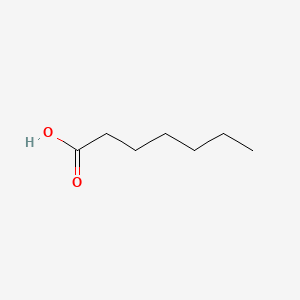| MeSH term | MeSH ID | Detail |
|---|---|---|
| Olfaction Disorders | D000857 | 17 associated lipids |
| Byssinosis | D002095 | 11 associated lipids |
| Mitochondrial Diseases | D028361 | 25 associated lipids |
HEPTANOIC ACID
HEPTANOIC ACID is a lipid of Fatty Acyls (FA) class. Heptanoic acid is associated with abnormalities such as Dehydration. The involved functions are known as Process, Anabolism, inhibitors, Oxidation and fatty acid oxidation. The related lipids are Heptanoates and undecanoic acid.
Cross Reference
Introduction
To understand associated biological information of HEPTANOIC ACID, we collected biological information of abnormalities, associated pathways, cellular/molecular locations, biological functions, related genes/proteins, lipids and common seen animal/experimental models with organized paragraphs from literatures.
What diseases are associated with HEPTANOIC ACID?
HEPTANOIC ACID is suspected in Dehydration and other diseases in descending order of the highest number of associated sentences.
Related references are mostly published in these journals:
| Disease | Cross reference | Weighted score | Related literature |
|---|
Possible diseases from mapped MeSH terms on references
We collected disease MeSH terms mapped to the references associated with HEPTANOIC ACID
PubChem Associated disorders and diseases
What pathways are associated with HEPTANOIC ACID
There are no associated biomedical information in the current reference collection.
PubChem Biomolecular Interactions and Pathways
Link to PubChem Biomolecular Interactions and PathwaysWhat cellular locations are associated with HEPTANOIC ACID?
There are no associated biomedical information in the current reference collection.
What functions are associated with HEPTANOIC ACID?
Related references are published most in these journals:
| Function | Cross reference | Weighted score | Related literatures |
|---|
What lipids are associated with HEPTANOIC ACID?
Related references are published most in these journals:
| Lipid concept | Cross reference | Weighted score | Related literatures |
|---|
What genes are associated with HEPTANOIC ACID?
There are no associated biomedical information in the current reference collection.
What common seen animal models are associated with HEPTANOIC ACID?
There are no associated biomedical information in the current reference collection.
NCBI Entrez Crosslinks
All references with HEPTANOIC ACID
Download all related citations| Authors | Title | Published | Journal | PubMed Link |
|---|---|---|---|---|
| Xu W et al. | Odorant-binding proteins of the malaria mosquito Anopheles funestus sensu stricto. | 2010 | PLoS ONE | pmid:21042539 |
| Aminsharifi A et al. | Preventive role of exogenous testosterone on cisplatin-induced gonadal toxicity: an experimental placebo-controlled prospective trial. | 2010 | Fertil. Steril. | pmid:19362306 |
| Verma S et al. | Bioconversion of heptanal to heptanol by Saccharomyces cerevisiae. | 2010 | Yeast | pmid:20120041 |
| Chaghi R et al. | Competitive interactions between components in surfactant-cosurfactant-additive systems. | 2010 | J Colloid Interface Sci | pmid:20110091 |
| Liang P et al. | Rate coefficients for reactions of OH and Cl with esters. | 2010 | Chemphyschem | pmid:20718067 |
| Rändler C et al. | A three-phase in-vitro system for studying Pseudomonas aeruginosa adhesion and biofilm formation upon hydrogel contact lenses. | 2010 | BMC Microbiol. | pmid:21062489 |
| Avasthi A et al. | Research on antipsychotics in India. | 2010 | Indian J Psychiatry | pmid:21836703 |
| Radhakrishnan R and Andrade C | The evolution of Indian psychiatric research: An examination of the early decades of the Indian Journal of Psychiatry. | 2010 | Indian J Psychiatry | pmid:21836678 |
| Olanga EA et al. | Attraction of Anopheles gambiae to odour baits augmented with heat and moisture. | 2010 | Malar. J. | pmid:20051143 |
| Kulhara P et al. | An overview of Indian research in schizophrenia. | 2010 | Indian J Psychiatry | pmid:21836674 |
| Rao TS et al. | Indian Psychiatry and Indian Journal of Psychiatry - A journey. | 2010 | Indian J Psychiatry | pmid:21836664 |
| Thrash JC et al. | Description of the novel perchlorate-reducing bacteria Dechlorobacter hydrogenophilus gen. nov., sp. nov.and Propionivibrio militaris, sp. nov. | 2010 | Appl. Microbiol. Biotechnol. | pmid:19921177 |
| Ahmad Tajidi NS et al. | Diaqua-(1,4,8,11-tetra-aza-cyclo-tetra-decane-κN,N,N,N)copper(II) dihepta-noate dihydrate. | 2010 | Acta Crystallogr Sect E Struct Rep Online | pmid:21588132 |
| Gu L et al. | Parenteral and enteral metabolism of anaplerotic triheptanoin in normal rats. II. Effects on lipolysis, glucose production, and liver acyl-CoA profile. | 2010 | Am. J. Physiol. Endocrinol. Metab. | pmid:19903863 |
| Coen PM et al. | Insulin resistance is associated with higher intramyocellular triglycerides in type I but not type II myocytes concomitant with higher ceramide content. | 2010 | Diabetes | pmid:19833891 |
| Magliano P et al. | Repercussion of a deficiency in mitochondrial ß-oxidation on the carbon flux of short-chain fatty acids to the peroxisomal ß-oxidation cycle in Aspergillus nidulans. | 2010 | Biochim. Biophys. Acta | pmid:20736083 |
| Dienstmaier JF et al. | On the scalability of supramolecular networks--high packing density vs optimized hydrogen bonds in tricarboxylic acid monolayers. | 2010 | Langmuir | pmid:20536167 |
| Lin CR et al. | Synthesis, characterization and magnetic properties of nearly monodisperse CuCr2Se4 nanoparticles. | 2010 | Nanotechnology | pmid:20463392 |
| Citrome L et al. | Treatment of schizophrenia with depot preparations of fluphenazine, haloperidol, and risperidone among inpatients at state-operated psychiatric facilities. | 2010 | Schizophr. Res. | pmid:20347267 |
| Pedernera-Romano C et al. | Effect of perphenazine enanthate on open-field test behaviour and stress-induced hyperthermia in domestic sheep. | 2010 | Pharmacol. Biochem. Behav. | pmid:19799930 |
